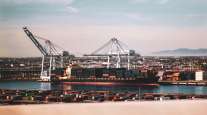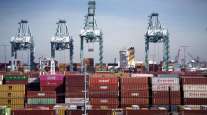Truck Turn Times Improve at SoCal Ports as Volumes Continue to Surge

The average time it took a truck driver to enter and exit the two largest ports in North America was 10 minutes quicker in November versus the same time a year ago, according to the Harbor Trucking Association.
The November average was 78 minutes across the 13 terminals at the ports of Los Angeles and Long Beach.
In Los Angeles, the average was 91 minutes and in Long Beach, Calif., it was 77 minutes.
Over the past 11 months, the average turn time has been three minutes quicker (83 minutes) than last year, despite Long Beach already topping last year’s total container traffic with one month to go in 2017.
In Los Angeles, barring a major abnormality this month, the port will shatter the Northern Hemisphere record it set last year of 8.8 million and surpass 9 million industry-standard 20-foot-equivalent units, or TEUs.

“We’ve had a strong 2017, but we still have a lot to work on. I’m hoping that we have the ability to continue to collaborate with our marine terminal partners to have an even stronger 2018,” HTA Executive Director Weston LaBar said.
The group teams with Geostamp to use geofencing and GPS on trucks to calculate the time between when a truck reaches the entrance queue and when it crosses the exit gate.
The quickest terminal was the lightly used Matson Terminal in Long Beach at 34 minutes. Middle Harbor, also known for quick turn times, slipped to 54 minutes. It was the first time the average exceeded 50 minutes in 2017.
LaBar tied the result to the additional volume coming into Middle Harbor (Pier E) as the massive renovation project moves to Pier F, but he expects the number to rebound in short order.
The slowest terminal was Total Terminals International in Long Beach, the busiest and largest terminal, at 98 minutes. However, it was a vast improvement from the 123-minute average one year ago when former owner Hanjin Shipping Co. was in the bankruptcy process. The November result marked only the third time that TTI averaged less than 100 minutes this year.
LaBar credited a new management team for engaging his association and certain fleets, seeking ideas from the trucking community on how to quicken the turns.
In Los Angeles, the slowest time was the West Basin Container Terminal at 108 minutes — the first time since March 2015 that the turn time was longer than 100 minutes. In October, the average was 78 minutes and it was 79 minutes in November 2016.
“They definitely saw an increase in volume, and it was a rough month. It’s definitely something we’ll have to monitor. Typically, when we see terminals have a drastic increase in volume, they aren’t ready to handle it right off the bat,” LaBar said.
#PortofLA set a new record for highest monthly container volumes, processing 924,225 TEUs in November. https://t.co/5fbmey2Osu pic.twitter.com/V1SQxJb1RS — Port of Los Angeles (@PortofLA) December 12, 2017
The Port of Los Angeles, North America’s busiest, established a near monthly record with 924,225 TEUs in November, surpassing the previous high mark of 877,564 set last November.
Loaded import containers grew 6.1% year-over-year to 463,690, while exports eked out a 0.3% gain to 177,913.
“Four vessels calling in Los Angeles each discharged and loaded more than 23,000 TEUs in November, close to October’s 24,308 TEU record set in Los Angeles,” Port of Los Angeles Executive Director Gene Seroka said. “We’re proud to be partnering with our labor and supply chain stakeholders to move these record-breaking cargo levels with efficiency, productivity and extraordinary customer service.”
Through November, cargo volumes have jumped 6.3% to 8.56 million TEUs. To break the record, Los Angeles will need 292,800 TEUs in December, a foregone conclusion since the port hasn’t fell below that amount in a month since 1999.
At the Port of Long Beach, No. 2 in North America, dockworkers handled 612,659 TEUs in November, an increase of nearly 15% from a year ago.
Loaded imports jumped 18% to 319,210, and exports went up 4.5% to 126,364. Port officials credit the surge in imports to a last-minute effort to stock the shelves for the holidays.
A total of 612,659 TEUs moved through the Port of Long Beach during November, an increase of 14.7% over the same month a year ago. The Port is on track to handle over 7 million containers for 2017.
Read more about this month's cargo numbers: https://t.co/AS2Rkf2bcQ pic.twitter.com/1vBO60ybOh — Port of Long Beach (@portoflongbeach) December 12, 2017
“U.S. consumers are confident, and the economy has been strong,” Long Beach Harbor Commission President Lou Anne Bynum said. “Retailers have been stocking goods as a result, and we are nearing cargo levels we have not seen since before the 2008 recession.”
“Our focus on speed and reliability has positioned the port to have its busiest year ever,” Port of Long Beach Executive Director Mario Cordero said.
Through November, the terminals have moved nearly 6.85 million TEUs, a 10% increase. The total for 2016 was 6.77 million TEUs, although the Hanjin bankruptcy disrupted the supply chain during late summer and autumn last year.




